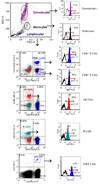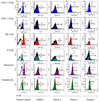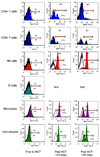A rapid flow cytometric screening test for X-linked lymphoproliferative disease due to XIAP deficiency
- PMID: 19288545
- PMCID: PMC2728163
- DOI: 10.1002/cyto.b.20473
A rapid flow cytometric screening test for X-linked lymphoproliferative disease due to XIAP deficiency
Abstract
Background: Deficiency of X-linked inhibitor of apoptosis (XIAP), caused by BIRC4 gene mutations, is the second known cause of X-linked lymphoproliferative disease (XLP), a rare primary immunodeficiency that often presents with life-threatening hemophagocytic lymphohistiocytosis (HLH). Rapid diagnosis of the known genetic causes of HLH, including XIAP deficiency, facilitates the initiation of life-saving treatment and preparation for allogeneic hematopoietic cell transplantation (HCT). Until now, a rapid screening test for XIAP deficiency has not been available.
Methods: To develop a flow cytometric screening test for XIAP deficiency, we first used lymphoblastic cell lines generated from controls and patients with BIRC4 mutations to identify two commercially available antibodies specific for native intracellular XIAP. Next, we used these antibodies to study control whole blood leukocyte XIAP expression. We then studied XIAP expression in leukocytes from patients with XLP due to BIRC4 mutations, maternal carriers, and patients following HCT.
Results: XIAP was expressed by the majority of all whole blood nucleated cells in normal controls. In contrast, XIAP was absent or decreased in all lymphocyte subsets, monocytes and granulocytes from four unrelated patients with XLP due to BIRC4 mutations. Bimodal distribution of XIAP expression was evident in two maternal carriers, with significant skewing toward cells expressing normal XIAP. Bimodal distribution was also observed in a patient following HCT.
Conclusions: Flow cytometric analysis of intracellular XIAP provides a rapid screening test for XLP due to XIAP deficiency. It also allows carrier detection and can be used to monitor donor versus recipient reconstitution following HCT.
(c) 2009 Clinical Cytometry Society.
Figures







References
-
- Rigaud S, Fondanèche MC, Lambert N, Pasquier B, Mateo V, Soulas P, et al. XIAP deficiency in humans causes an X-linked lymphoproliferative syndrome. Nature. 2006;444:110–114. - PubMed
-
- Tabata Y, Villanueva J, Lee SM, Zhang K, Kanegane H, Miyawaki T, et al. Rapid detection of intracellular SH2D1A protein in cytotoxic lymphocytes from patients with X-linked lymphoproliferative disease and their family members. Blood. 2005;105:3066–3071. - PubMed
-
- Kogawa K, Lee SM, Villanueva J, Marmer D, Sumegi J, Filipovich AH. Perforin expression in cytotoxic lymphocytes from patients with hemophagocytic lymphohistiocytosis and their family members. Blood. 2002;99:61–66. - PubMed
-
- Tosato G, Cohen JI. Generation of Epstein-Barr Virus (EBV)–Immortalized B Cell Lines. Curr Protoc Immunol. 2007 sup 76:Unit 7.22. - PubMed
Publication types
MeSH terms
Substances
Grants and funding
LinkOut - more resources
Full Text Sources
Other Literature Sources

